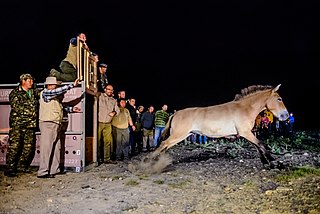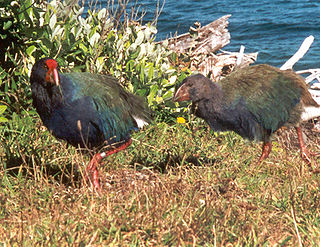
The European bison or the European wood bison, also known as the wisent, the zubr, or sometimes colloquially as the European buffalo, is a European species of bison. It is one of two extant species of bison, alongside the American bison. The European bison is the heaviest wild land animal in Europe, and individuals in the past may have been even larger than their modern-day descendants. During late antiquity and the Middle Ages, bison became extinct in much of Europe and Asia, surviving into the 20th century only in northern-central Europe and the northern Caucasus Mountains. During the early years of the 20th century, bison were hunted to extinction in the wild.

Species reintroduction is the deliberate release of a species into the wild, from captivity or other areas where the organism is capable of survival. The goal of species reintroduction is to establish a healthy, genetically diverse, self-sustaining population to an area where it has been extirpated, or to augment an existing population. Species that may be eligible for reintroduction are typically threatened or endangered in the wild. However, reintroduction of a species can also be for pest control; for example, wolves being reintroduced to a wild area to curb an overpopulation of deer. Because reintroduction may involve returning native species to localities where they had been extirpated, some prefer the term "reestablishment".

In paleontology, a Lazarus taxon is a taxon that disappears for one or more periods from the fossil record, only to appear again later. Likewise in conservation biology and ecology, it can refer to species or populations that were thought to be extinct, and are rediscovered. The term Lazarus taxon was coined by Karl W. Flessa and David Jablonski in 1983 and was then expanded by Jablonski in 1986. Paul Wignall and Michael Benton defined Lazarus taxa as, "At times of biotic crisis many taxa go extinct, but others only temporarily disappeared from the fossil record, often for intervals measured in millions of years, before reappearing unchanged". Earlier work also supports the concept though without using the name Lazarus taxon, like work by Christopher R. C. Paul.

The Wilder Institute/Calgary Zoo is located in Bridgeland, Calgary, Alberta, Canada, just east of the city's downtown and adjacent to the Inglewood and East Village neighborhoods. It is accessible via Calgary's C-Train light rail system, by car via Memorial Drive, and by bicycle and footpath via the Bow River pathway. A large portion of the zoo is located on St. George's Island in the Bow River.

The Omilteme cottontail is a species of cottontail rabbit found only in the Mexican state of Guerrero, in the Sierra Madre del Sur mountain range. Belonging to the family Leporidae, it is one of fourteen species in the genus Sylvilagus, a genus restricted to the New World. The Omilteme cottontail is considered one of the most endangered rabbit species in the world and is only known from a few specimens.

The western quoll is Western Australia's largest endemic mammalian carnivore. One of the many marsupial mammals native to Australia, it is also known as the chuditch. The species is currently classed as near-threatened.

Porrhothele antipodiana, the black tunnelweb spider, is a species of mygalomorph spider that lives in New Zealand. It is the most common and widespread of several species in the genus Porrhothele, and is especially common in the greater Wellington region where the vagrant mature males are often encountered in or around dwellings. This species is one of New Zealand's most studied spiders. In New Zealand, the common name "tunnelweb spider" is also often used to refer to members of the genus Hexathele. Neither should be confused with their distant relatives, the highly venomous Australian funnel-web spiders.

De Winton's golden mole is a species of mammal in the family Chrysochloridae. It is endemic to South Africa. Its natural habitats are subtropical dry shrubland, Mediterranean-type shrubby vegetation, and sandy shores. It is threatened by habitat destruction and is "critically endangered". It was named after British zoologist William Edward de Winton.

Liphistius is a genus of basal trapdoor spiders in the family Liphistiidae. They are found in Japan, China, and Southeast Asia.
Austroomphaliaster is a fungal genus in the family Tricholomataceae. It is a monotypic genus, containing the single species Austroomphaliaster nahuelbutensis, also known as the Big Puma Mushroom, Austroomphaliaster nahuelbutensis was found in temperate South America. This species lived on Patagonian Oak Trees and Dombey’s Beech Tree. This species hasn’t been seen in 35 years and is part of Re:wild’s Search For Lost Species Initiative. In May 2023, specimens have been found which may be Austroomphaliaster nahuelbutensis, but DNA analysis is still needed to confirm the identity.

Australia has a number of highly venomous spiders, including the Sydney funnel-web spider, its relatives in the family Hexathelidae, and the redback spider, whose bites can be extremely painful and have historically been linked with deaths in medical records. Most Australian spiders do not have venom that is considered to be dangerously toxic. No deaths caused by spider bites in Australia have been substantiated by a coronial inquest since 1979. There are sensationalised news reports regarding Australian spiders that fail to cite evidence. A Field Guide to Spiders of Australia published by CSIRO Publishing in 2017 featuring around 836 species illustrated with photographs of live animals, around 381 genera and 78 families, introduced significant updates to taxonomy from Ramirez, Wheeler and Dmitrov.
Ummidia algarve is a spider species found in Portugal. Unlike other known Ummidia species, it creates a trapdoor at the entrance of the burrow.
Rewilding Europe is a non-profit organization based in Nijmegen, the Netherlands, dedicated to creating rewilded landscapes throughout Europe. The group's efforts have contributed to increasing the stock of previously endangered species such as the European bison and the Iberian lynx.
Iberesia is a genus of spiders in the family Nemesiidae. It was first described in 2006 by Decae & Cardoso. As of 2021, it contains 6 Mediterranean species.

Nemesia is a genus of mygalomorph spiders in the family Nemesiidae, first described by Jean Victoire Audouin in 1826.

Celtic Rewilding, formally known as Celtic Reptile & Amphibian, is a conservation company, established in 2020, by Harvey Tweats and Tom Whitehurst, with the initial aim of reintroducing extinct reptiles and amphibians back to rewilding projects within the UK. However, the company's scope has since broadened to all lost species of the UK and northern Europe. It is based in Leek, Staffordshire.
Euoplos dignitas is a species of armoured golden trapdoor spider in the family Idiopidae. It is found in Queensland, Australia.












